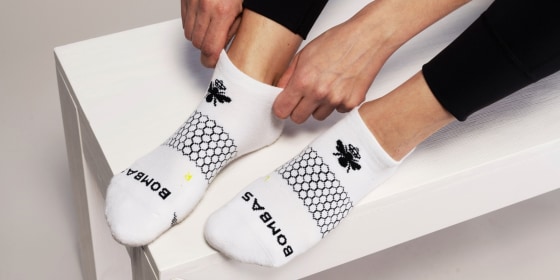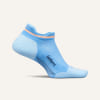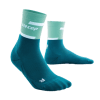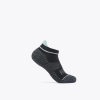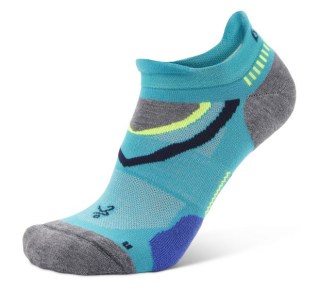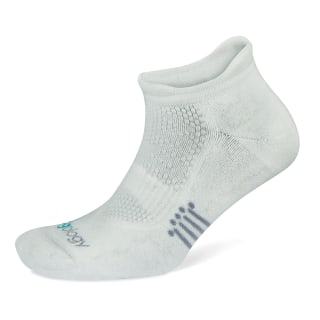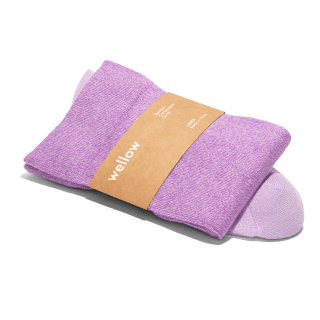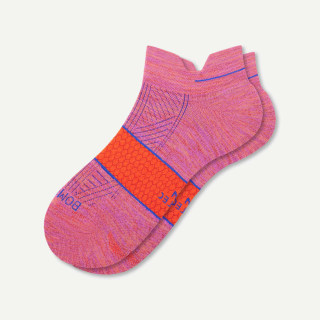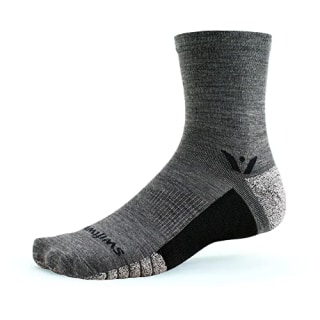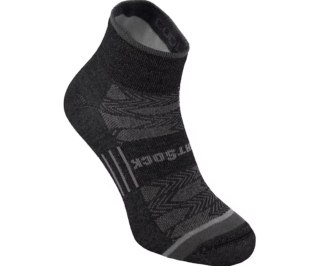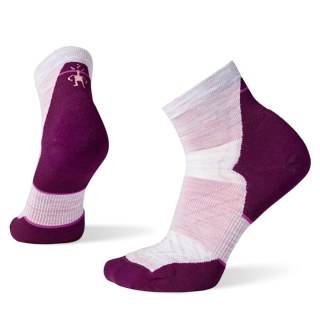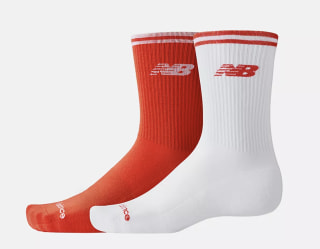Wearing the wrong running socks can ruin your run. “The biggest problem is the formation of blisters, says Dr. Lori Grant, MD, a board-certified foot and ankle surgeon at Orlando Health who specializes in wound care and sports-related injuries. “The wrong socks can cause little wounds or sores on your feet.”
To help you keep your runs pain- and injury-free, we asked three podiatrists and a running coach for their favorite running socks and guidance on how to find the right fit, fabric, and functionality for your feet.
SKIP AHEAD How we picked the best running socks | The best running socks in 2024 | How to shop for running socks | When to replace your running socks | Signs you’re wearing the wrong running socks
How we picked the best running socks
Our experts agree that there’s a certain amount of personal preference involved with choosing the best running socks. But to help you identify the best ones in an endless sea of options, we asked them to weigh in on the fabrics, features, and cuts most likely to protect and support your feet during a run, whether you’re working toward your first 5k or 10th marathon.
- Fabric: Moisture-wicking fabric blends are a must for running socks. “You want a sock to help wick away any sweat you build up while running, to increase ventilation, and protect your feet and toes from rubbing and chafing,” says Steve Mura, the Manager of Runner Training & Education for New York Road Runners. Look for socks made with a fabric blend of Merino wool or synthetic fibers like nylon, spandex, polyester, and lycra. Whatever you do, our experts advise staying away from socks with a high percentage of cotton, which absorbs moisture rather than wicking it away. “You’re going to be uncomfortable because your foot is going to be wet and you may also end up falling prey to skin and nail infections from running with stagnant, wet material on your foot,” says Dr. Adenike Sonaike, DPM, a podiatrist and Medical Director with Baker Street Health in Motion, practicing in New York and New Jersey.
- Compression: The second feature to look for in a running sock is some level of compression, which can help prevent mid-run foot swelling (and the subsequent blisters and chafing that can cause). “Compression is also helpful for people who have certain foot conditions like plantar fasciitis or any type of Morton’s neuroma,” says Grant. “It can help alleviate some of that pain and pressure.” Look for socks with compression in the arch and ankle.
- Cut: The best cut for running socks often comes down to personal preference, but more fabric can deliver more benefits. Calf socks can help support runners with shin splints while crew socks with mild compression can support ankle stability. If you prefer a low-cut ankle sock, look for a version with a blister tab to protect your Achilles from chafing.
- Price: The price of running socks can vary widely, but you often get what you pay for, says Grant. If you’re a frequent runner, investing in a few good pairs of running socks can be a smart strategy for preventing injury.
Want more from NBC Select? Sign up for our newsletter, The Selection, and shop smarter.
The best running socks in 2024
Balega UltraGlide No-Show Tab
- Friction-free yarn
- Lightweight
- 1-year warranty
- Run small
Sonaike recommends Balega’s running socks as one of the more technically advanced options on the market. “They studied runner’s biomechanics and then created a sock to support that,” she says. The UltraGlide No-Show socks are entirely seamless to prevent blisters and sore spots and are designed with ventilation panels to help keep feet cool. I particularly like the anti-blister tabs at the back and front of the sock, which provides a comfortable no-show alternative to ankle and crew socks.
Fabric: 78% drynamix® recycled polyester, 20% nylon, 2% elastane | Compression: arch support | Sock height: no-show | Sock cushioning: light | Moisture-wicking: yes
Jogoly High Cushion No Show Socks
- Protective padding for toes
- Ventilation panels
- Arch support
- The socks are asymmetrical
“These are the softest, most highly cushioned socks I own,” says NBC Select reporter Zoe Malin, who runs between 28 and 35 miles per week. “They’re not super thick, so they don’t make my shoes feel tighter, and they never make my feet hot, even in the summer. I especially love wearing these socks on long runs when the bottoms of my feet tend to feel the most achy. The extra cushioning really comes in handy when I’m getting up there in terms of mileage.”
Fabric: N/a | Compression: no | Sock height: no-show | Sock cushioning: high | Moisture-wicking: yes
Feetures Elite Max Cushion Tab
- Tab to prevent blisters
- Comes in fun colors
- Plush feel
- Brand recommends air drying
All of Feetures’ socks are designed for an anatomical fit — i.e. socks specific to the right and left foot — and you can really feel the extra snugness. When I ran in this pair for the first time, I appreciated the total lack of bunching or slipping as well as the softness and the mesh weave that kept my feet cool. In addition to the functional features including a cushioned blister tab, targeted arch compression, and seamless toe and heel design, Sonaike also likes these for their aesthetics. “They’re low profile so they fit really nicely into sneakers,” she says.
Fabric: 74% polyester; 21% nylon; 5% spandex | Compression: arch support | Sock height: ankle | Sock cushioning: plush | Moisture-wicking: yes
Cep The Run Compression Mid Cut Socks 4.0
- Full compression
- Toe ventilation
- Antibacterial
- May not fit all calf sizes
For full compression, Sonaike recommends Cep socks, which come in various cuts and weights to tailor to your personal preferences. (There’s even a reflective pair for night runs.) If you’re new to compression, these are a great place to start. They’re well-priced and moderately cushioned for extra comfort. The polyamide and spandex blend is not only moisture-wicking, but coated with an antimicrobial silver solution to inhibit the growth of bacteria and odors, according to the brand.
Fabric: 86% polyamide, 14% spandex | Compression: medium (18-20 mmHg) | Sock height: crew | Sock cushioning: moderate | Moisture-wicking: yes
Wellow Wide Calf Compression Sock
- Size-inclusive
- Come in fun colors
- Soft
- Air drying recommended
For a wide-calf compression option, Dr. Priya Parthasarathy, DPM, a podiatrist based in Silver Spring, Maryland recommends Wellow’s compression socks. While not specifically designed for running, they still check off many of our experts’ top recommendations since they’re woven from moisture-wicking fabric and have a seamless toe and heel design. The knee-length design is also ideal for runners dealing with shin splints.
Fabric: 76% viscose made from bamboo, 16% polyester, 6% spandex, 2% nylon | Compression: medium (18-25 mmHg) | Sock height: knee | Sock cushioning: plush | Moisture-wicking: yes
Bombas Women’s Running Ankle Socks
- Tab to prevent blisters
- Airflow venting
- Seamless toe
- Small percentage of cotton
Bombas’ signature running ankle socks are lightly compressive and have a tab to prevent blisters from forming. They’re a favorite of Parthasarathy’s for their just-right level of light cushioning and breathability. They also have a seamless toe design to prevent toenail loss.
Fabric: 58% polyester, 23% nylon, 15% cotton, 4% elastane | Compression: arch support | Sock height: ankle | Sock cushioning: light | Moisture-wicking: yes
Swiftwick Flite XT Trail Mid-Crew
- Moisture-wicking
- Prevents blisters
- Keeps foot in place
- May run a bit small
“These socks are marketed for hiking and trail running, but I’ve also used them for road running and cycling,” says NBC Select reporter Harry Rabinowitz, who typically bike rides about 10 miles per week. “The reason I love them is the mix of fabric: just enough Merino wool to be warm, but not so much that they feel itchy or uncomfortable (since wool usually bothers my skin). They’re slightly cushioned and compressive, but no so much so that I have to think about which shoes I pair them with. They’re machine washable and dryable, though sometimes I hang dry them, as they’re very expensive socks that I want to last for years.”
Fabric: 38% nylon, 24% Merino wool, 22% olefin, 13% polyester, 3% spandex | Compression: moderate | Sock height: mid-crew | Sock cushioning: medium | Moisture-wicking: yes
Wrightsock CoolMesh II Quarter Anti-Blister System
- Good for warm temps
- Breathable
- Buyers note lack of durability
Wrightsock’s CoolMesh Quarter socks are a versatile choice: They provide light compression for travel, support for hiking, and breathability for running, according to the brand. “They’re very breathable specifically for the summer,” says Sonaike. Compression in the arch helps prevent swelling and slipping and a unique double-layer design helps absorb friction between your shoe and your foot to prevent blisters. (Like Cep, Wrightsock has an anti-blister guarantee for its products.)
Fabric: 70% recycled polyester, 26% nylon, 4% lycra | Compression: arch support | Sock height: crew | Sock cushioning: plush | Moisture-wicking: yes
Hoka All-Gender No-Show Run Sock
- Reflective detailing
- Well-priced
- Small percentage of cotton
Parathasarathy recommends Hoka’s run socks for their “really nice and snug” fit. She also likes the seamless toe design for patients to prevent blisters and toenail loss.
Fabric: 37% nylon, 32% polyester, 14% polyester, 14% cotton, 3% elastane | Compression: arch support | Sock height: ankle | Sock cushioning: plush | Moisture-wicking: yes
Smartwool Run Ankle Socks
- Merino wool blend
- Seamless toe
- Targeted cushioning
- Some find the cushioning bulky
For cold weather runs, Sonaike likes Smartwool’s running socks, which come in a variety of cuts. “They’re a thin merino wool blend and have specific padding around the toe and the heel [for added comfort],” she says. In addition to keeping your feet warm in colder temperatures, merino wool also does an excellent job at keeping feet cool in the heat, according to our experts, making these a versatile year-round pair.
Fabric: 54% Merino Wool 41% Nylon 2% Recycled Nylon 3% Elastane | Compression: Light | Sock height: Ankle | Sock cushioning: Targeted | Moisture-wicking: Yes
New Balance Running Stripe Mid-Calf Sock
- Stylish
- Soft
- Snug on calves
“I love a bright sock that comes up to my calf, which is why I like the New Balance Running Stripe Midcalf Sock,” says Mura. “It comes in various colors and is made of polyester to keep my feet feeling good for the run, whether that is a 5K or a marathon.”
Fabric: Polyester | Compression: Light | Sock height: Crew | Sock cushioning: Light | Moisture-wicking: Yes
How to shop for running socks
Finding the best running socks will likely involve considering personal preferences (i.e. style, cut, level of cushioning, etc.). To help guide you, our experts recommend the following:
Fabric
Choosing a synthetic or wool-blend sock is about more than just temperature and moisture regulation. It might also help prevent foot infections. “Because cotton retains moisture, it increases your risk of blisters,” says Grant. “Having moisture inside a running shoe for prolonged periods can also increase your risk of even developing athlete’s feet or fungus.”
Compression
All three doctors we spoke to for this story noted the importance of compression for running socks in helping to reduce swelling and pain. But what’s the ideal level of compression? It’s a matter of personal preference, says Grant, but for most runners without medical conditions affecting circulation, 15-18 mmHg is plenty.
Cut
When deciding the best cut for your personal needs, Grant recommends considering your pressure points. Are you prone to blisters on the back of the heel? Ankle socks or no-show socks with blister tabs are safe bets. Are you prone to slippage from your socks? You may want to opt for a taller crew sock. If you’re battling shin splints, knee high compression socks can provide added support.
Temperature control
The level of cushioning in a running sock will affect its temperature control ability, says Grant. Ultrathin socks can actually make your feet sweatier as they’re less able to wick moisture and that can cause cold feet.
When to replace your running socks
If you notice any of the following signs, it’s time to replace your socks:
- Holes in the toes or heels
- Sagging
- Bunching
- Loss of shape
Signs you’re wearing the wrong running socks
Sometimes the socks with the most rave reviews just don’t work for your individual foot mechanics. Here are the signs that a running sock isn’t working for you, according to Sonaike:
- Your foot is overheating
- Bunching near the toes or in the arches
- Socks are sliding down
- Blisters
Meet our experts
At NBC Select, we work with experts who have specialized knowledge and authority based on relevant training and/or experience. We also take steps to ensure all expert advice and recommendations are made independently and without undisclosed financial conflicts of interest.
- Dr. Priya Parthasarathy, DPM, is a podiatrist based in Silver Spring, Maryland. She’s a spokesperson for the American Podiatric Medical Association and practices with the U.S. Foot and Ankle Specialists, specializing in general foot and ankle care, foot pain, and sports medicine.
- Dr. Adenike Sonaike, DPM, is a podiatrist and Medical Director with Baker Street Health in Motion, practicing in New York and New Jersey. She specializes in general foot and ankle care, sports medicine, tendon health, and biomechanics.
- Dr. Lori Grant, MD, is a board-certified foot and ankle surgeon at Orlando Health who specializes in the medical and surgical treatment of all foot and ankle conditions including wound care, bunions, and sports-related injuries.
- Steve Mura is the Manager of Runner Training & Education for New York Road Runners. He is an RRCA and VDot02 certified coach and has coached hundreds of runners in person and online each year.
Why trust NBC Select?
Macaela MacKenzie is a journalist and former Glamour editor who has covered fitness and wellness for over a decade. For this article, MacKenzie spoke to three podiatrists and a trainer for New York Road Runners. She also drew on her personal experience as a distance runner.
Catch up on Select’s in-depth coverage of personal finance, tech and tools, wellness and more, and follow us on Facebook, Instagram, Twitter and TikTok to stay up to date.
